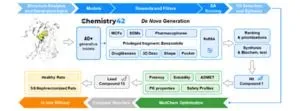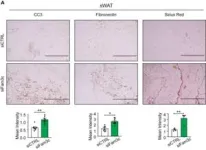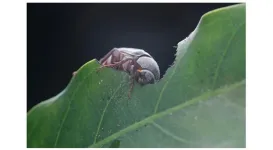(Press-News.org) BUFFALO, N.Y. – Think of a time when you had two different but similar experiences in a short period. Maybe you attended two holiday parties in the same week or gave two presentations at work. Shortly afterward, you may find yourself confusing the two, but as time goes on that confusion recedes and you are better able to differentiate between these different experiences.
New research published in Nature Neuroscience published on January 19, reveals that this process occurs on a cellular level, findings that are critical to the understanding and treatment of memory disorders, such as Alzheimer’s disease.
Dynamic engrams store memories
The research focuses on engrams, which are neuronal cells in the brain that store memory information. “Engrams are the neurons that are reactivated to support memory recall,” says Dheeraj S. Roy, PhD, one of the paper’s senior authors and an assistant professor in the Department of Physiology and Biophysics in the Jacobs School of Medicine and Biomedical Sciences at the University at Buffalo. “When engrams are disrupted, you get amnesia.”
In the minutes and hours that immediately follow an experience, he explains, the brain needs to consolidate the engram to store it. “We wanted to know: What is happening during this consolidation process? What happens between the time that an engram is formed and when you need to recall that memory later?”
The researchers developed a computational model for learning and memory formation that starts with sensory information, which is the stimulus. Once that information gets to the hippocampus, the part of the brain where memories form, different neurons are activated, some of which are excitatory and others that are inhibitory.
When neurons are activated in the hippocampus, not all are going to be firing at once. As memories form, neurons that happen to be activated closely in time become a part of the engram and strengthen their connectivity to support future recall.
“Activation of engram cells during memory recall is not an all or none process but rather typically needs to reach a threshold (i.e., a percentage of the original engram) for efficient recall,” Roy explains. “Our model is the first to demonstrate that the engram population is not stable: The number of engram cells that are activated during recall decreases with time, meaning they are dynamic in nature, and so the next critical question was whether this had a behavioral consequence.”
Dynamic engrams are needed for memory discrimination
“Over the consolidation period after learning, the brain is actively working to separate the two experiences and that’s possibly one reason why the numbers of activated engram cells decrease over time for a single memory,” he says. “If true, this would explain why memory discrimination gets better as time goes on. It’s like your memory of the experience was one big highway initially but over time, over the course of the consolidation period on the order of minutes to hours, your brain divides them into two lanes so you can discriminate between the two.”
Roy and the experimentalists on the team now had a testable hypothesis, which they carried out using a well-established behavioral experiment with mice. Mice were briefly exposed to two different boxes that had unique odors and lighting conditions; one was a neutral environment but in the second box, they received a mild foot shock.
A few hours after that experience, the mice, who typically are constantly moving, exhibited fear memory recall by freezing when exposed to either box. “That demonstrated that they couldn’t discriminate between the two,” Roy says. “But by hour twelve, all of a sudden, they exhibited fear only when they were exposed to the box where they were uncomfortable during their very first experience. They were able to discriminate between the two. The animal is telling us that they know this box is the scary one but five hours earlier they couldn’t do that.”
Using a light-sensitive technique, the team was able to detect active neurons in the mouse hippocampus as the animal was exploring the boxes. The researchers used this technique to tag active neurons and later measure how many were reactivated by the brain for recall. They also conducted experiments that allowed a single engram cell to be tracked across experiences and time. “So I can tell you literally how one engram cell or a subset of them responded to each environment across time and correlate this to their memory discrimination,” explains Roy.”
The team’s initial computational studies had predicted that the number of engram cells involved in a single memory would decrease over time, and the animal experiments bore that out.
“When the brain learns something for the first time, it doesn’t know how many neurons are needed and so on purpose a larger subset of neurons is recruited,” he explains. “As the brain stabilizes neurons, consolidating the memory, it cuts away the unnecessary neurons, so fewer are required and in doing so helps separate engrams for different memories.”
What is happening with memory disorders?
The findings have direct relevance to understanding what is going wrong in memory disorders, such as Alzheimer’s disease. Roy explains that to develop treatments for such disorders, it is critical to know what is happening during the initial memory formation, consolidation and activation of engrams for recall.
“This research tells us that a very likely candidate for why memory dysfunction occurs is that there is something wrong with the early window after memory formation where engrams must be changing,” says Roy.
He is currently studying mouse models of early Alzheimer’s disease to find out if engrams are forming but not being correctly stabilized. Now that more is known about how engrams work to form and stabilize memories, researchers can examine which genes are changing in the animal model when the engram population decreases.
“We can look at mouse models and ask, are there specific genes that are altered? And if so, then we finally have something to test, we can modulate the gene for these ‘refinement’ or ‘consolidation’ processes of engrams to see if that has a role in improving memory performance,” he says.
Now at the Jacobs School, Roy conducted the research while a McGovern Fellow at the Broad Institute of Massachusetts Institute of Technology (MIT) and Harvard University. Roy is one of three neuroscientists recruited to the Jacobs School this year to launch a new focus on systems neuroscience in the school’s Department of Physiology and Biophysics.
Co-authors on the paper are from Imperial College in London; the Institute of Science and Technology in Austria; the McGovern Institute for Brain Research at MIT; and the Center for Life Sciences & IDG/McGovern Institute for Brain Research at Tsinghua University in China.
The work was funded by the President’s PhD Scholarship from Imperial College London; Wellcome Trust; the Biotechnology and Biological Sciences Research Council; the Simons Foundation; the Engineering and Physical Sciences Research Council; the School of Life Sciences and the IDG/McGovern Institute for Brain Research. Roy was supported by the Warren Alpert Distinguished Scholar Award and the National Institutes of Health.
END
Research into the nature of memory reveals how cells that store information are stabilized over time
Neuroscientists demonstrate how the brain improves its ability to distinguish between similar experiences, findings that could lead to treatments for Alzheimer’s disease and other memory disorders
2024-01-19
ELSE PRESS RELEASES FROM THIS DATE:
Generative AI helps to explain human memory and imagination
2024-01-19
Recent advances in generative AI help to explain how memories enable us to learn about the world, re-live old experiences and construct totally new experiences for imagination and planning, according to a new study by UCL researchers.
The study, published in Nature Human Behaviour and funded by Wellcome, uses an AI computational model – known as a generative neural network - to simulate how neural networks in the brain learn from and remember a series of events (each one represented by a simple scene).
The ...
KIST's 'Moonwalk', a robot that makes climbing Bukhansan Mountain easier
2024-01-19
As people age, they gradually lose muscle strength in their arms and legs, making it difficult for them to participate in leisure activities such as hiking and traveling, and they often need to rely on assistive devices such as canes and wheelchairs for mobility. However, these assistive devices do not improve muscle strength, so wearable robots that can compensate for the lack of muscle strength with the help of robots are attracting attention as an innovative technology to improve the health and quality of life of the elderly.
Dr. Lee Jongwon of the Intelligent Robotics Research Center at the Korea Institute of Science and Technology(KIST) ...
New air purifier design with innovative foam technology promises virus-stopping performance and zero waste
2024-01-19
Researchers at the University of Bath have invented a new form of high-performance air purifier that promises zero harmful waste.
Key to the purifier and how it works is FOAM3R filter technology, patented by the University, which is described as a highly adaptable disruptor technology for microbial, CO2 and volatile organic compound (VOC) odour removal.
FOAM3R can be used to produce multi-functional foam structures for a wide range of applications, including aircraft cabins, in-car air filters, ship and boat cabins, residential heating, ventilation and air-conditioning, home air purifiers and respirator and breathing apparatus.
The ...
Survey offers insights on childlessness and childcare in the UK
2024-01-19
Young people are increasingly planning to not have children
Millennials with stronger environmental concerns are less likely to intend to have a child, but this isn’t the case for Gen Z
Lower-income families spend more of their income on childcare than wealthier households
Parents pay an average of £560 a month on childcare – with a quarter paying over £800
A comprehensive new survey reveals the changing face of UK families amid recent economic, social, and political turmoil.
The methodology and initial findings from the UK Generations and Gender Survey are being presented today [Friday 19th January] ...
New study is one of first to show people with evidence of any remission of diabetes from weight-loss trial had a 40% lower rate of cardiovascular disease and 33% lower rate of chronic kidney disease
2024-01-19
While several trials have shown that substantial weight loss using diet and lifestyle can reverse type 2 diabetes, new research published in Diabetologia (the journal of the European Association of the Study of Diabetes [EASD]) is among the first to show the subsequent impact of remission on cardiovascular outcomes. The study is by Professor Edward Gregg, Head of the School of Population Health, RCSI University of Medicine and Health Sciences, Dublin, Ireland, and colleagues.
The new study shows that in patients that took part in the Look ...
RCSI research shows new benefits of weight loss for type 2 diabetes
2024-01-19
18 January 2024: Researchers in the School of Population Health at RCSI University of Medicine and Health Sciences have provided new evidence of the health benefits of weight loss efforts that lead to diabetes remission for type 2 diabetes patients.
For participants in the weight-loss trial who were able to achieve remission i.e. reduce the need for medications and reduce their HbA1c levels (a measure of blood sugar control), the research found there was a 40% lower rate of cardiovascular disease and 33% lower rate of chronic kidney disease in this group.
While previous trials have shown that substantial weight loss using diet and lifestyle can reverse type ...
Rice research opens new arena to study quantum interactions
2024-01-18
HOUSTON – (Jan. 18, 2024) – Quantum technologies bring the promise of faster computing, enhanced drug development and new sensing applications. However, quantum behaviors are difficult to study experimentally since most systems can only sustain quantum effects for a short time.
“The reason why quantum physics’ mysterious features tend to vanish so quickly is a process called decoherence,” said Kaden Hazzard, associate professor of physics and astronomy at Rice University and a corresponding author on a study published in Nature Physics. “It occurs when a quantum system ...
For this beetle, ‘date night’ comes every other day
2024-01-18
Life on Earth runs on a 24-hour cycle as the planet turns. Animals and plants have built-in circadian clocks that synchronize metabolism and behavior to this daily cycle. But one beetle is out of sync with the rest of nature.
A new study, published Jan. 18 in Current Biology, looks at a beetle with a unique, 48-hour cycle. The large black chafer beetle, Holotrichia parallela, is an agricultural pest in Asia. Every other night, the female beetles emerge from the soil, climb up a host plant ...
National Science Foundation taps NYU Tandon with $5 million grant to advance accessibility
2024-01-18
A team at NYU Tandon School of Engineering will kick off the second phase of an ambitious research project that aims to transform navigation and accessibility for many of the 285 million people with blindness and low vision (pBLV) worldwide.
The National Science Foundation (NSF) awarded the project a three-year $5 million grant last month.
Led by John-Ross Rizzo – an associate professor in NYU Tandon’s Biomedical Engineering department, associate director of NYU WIRELESS, affiliated faculty at the NYU Tandon Center for Urban Science and Progress (CUSP) and associate professor in the Department of Rehabilitation Medicine at NYU ...
Texas A&M AgriLife Research study may lead to novel obesity treatment
2024-01-18
MEDIA INQUIRES
WRITTEN BY
Laura Muntean
Paul Schattenberg
laura.muntean@ag.tamu.edu
paschattenberg@ag.tamu.edu
601-248-1891
210-859-5752
FOR ...
LAST 30 PRESS RELEASES:
Air pollution exposure and birth weight
Obstructive sleep apnea risk and mental health conditions among older adults
How talking slows eye movements behind the wheel
The Ceramic Society of Japan’s Oxoate Ceramics Research Association launches new international book project
Heart-brain connection: international study reveals the role of the vagus nerve in keeping the heart young
Researchers identify Rb1 as a predictive biomarker for a new therapeutic strategy in some breast cancers
Survey reveals ethical gaps slowing AI adoption in pediatric surgery
Stimulant ADHD medications work differently than thought
AI overestimates how smart people are, according to HSE economists
HSE researchers create genome-wide map of quadruplexes
Scientists boost cell "powerhouses" to burn more calories
Automatic label checking: The missing step in making reliable medical AI
Low daily alcohol intake linked to 50% heightened mouth cancer risk in India
American Meteorological Society announces Rick Spinrad as 2026 President-Elect
Biomass-based carbon capture spotlighted in newly released global climate webinar recording
Illuminating invisible nano pollutants: advanced bioimaging tracks the full journey of emerging nanoscale contaminants in living systems
How does age affect recovery from spinal cord injury?
Novel AI tool offers prognosis for patients with head and neck cancer
Fathers’ microplastic exposure tied to their children’s metabolic problems
Research validates laboratory model for studying high-grade serous ovarian cancer
SIR 2026 delivers transformative breakthroughs in minimally invasive medicine to improve patient care
Stem Cell Reports most downloaded papers of 2025 highlight the breadth and impact of stem cell research
Oxford-led study estimates NHS spends around 3% of its primary and secondary care budget on the health impacts of heat and cold in England
A researcher’s long quest leads to a smart composite breakthrough
Urban wild bees act as “microbial sensors” of city health.
New study finds where you live affects recovery after a hip fracture
Forecasting the impact of fully automated vehicle adoption on US road traffic injuries
Alcohol-related hospitalizations from 2016 to 2022
Semaglutide and hospitalizations in patients with obesity and established cardiovascular disease
Researchers ‘listen in’ to embryo-mother interactions during implantation using a culture system replicating the womb lining
[Press-News.org] Research into the nature of memory reveals how cells that store information are stabilized over timeNeuroscientists demonstrate how the brain improves its ability to distinguish between similar experiences, findings that could lead to treatments for Alzheimer’s disease and other memory disorders







